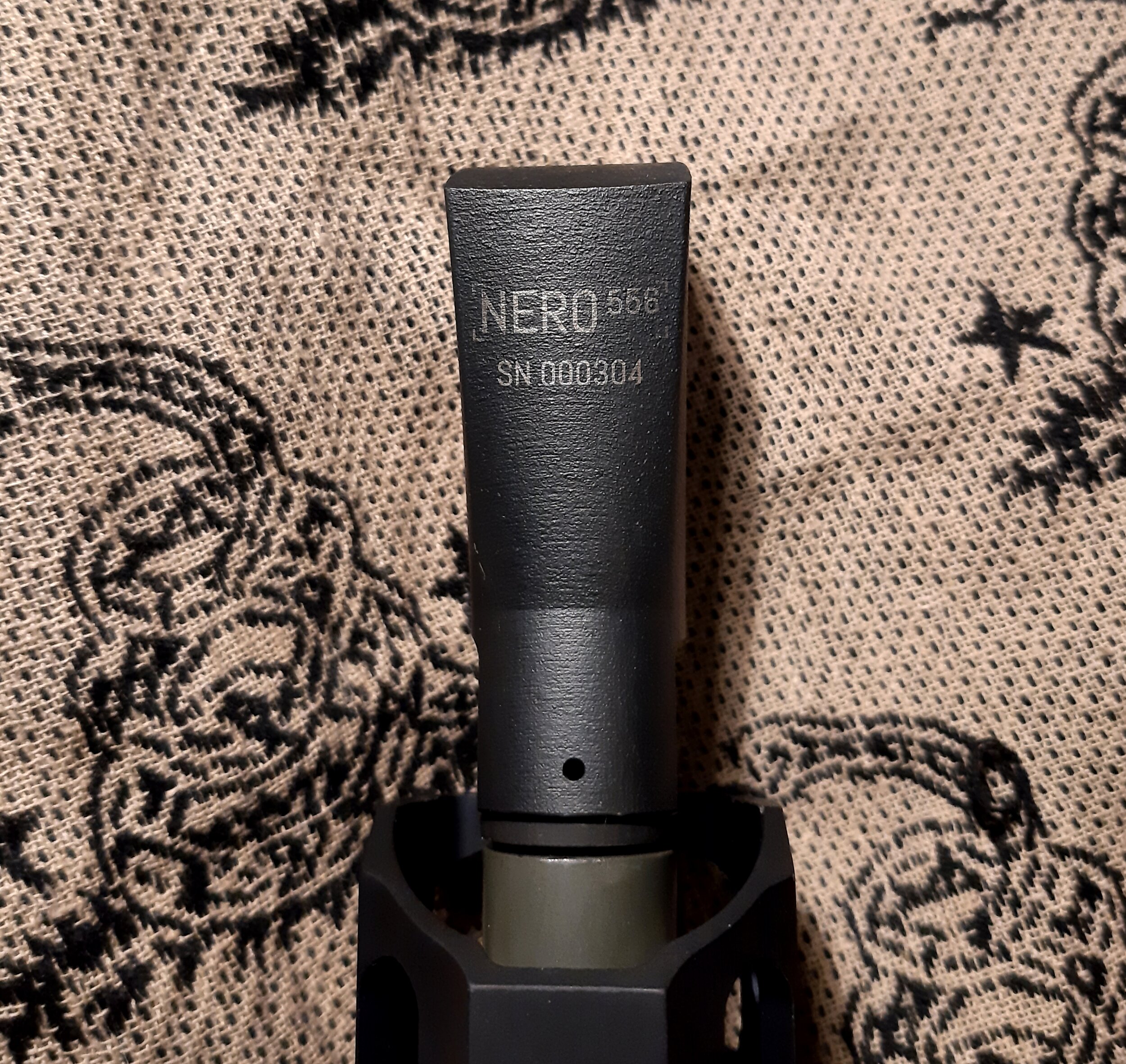Expo Arms, in collaboration with Forward Controls, introduced an extended muzzle brake for use with certain Dead Air silencers. This brake uses the “Keymo” mounting option and is for use on .223/5.56 suppressors, but it will also work on any .223/5.56 AR style rifle as just a normal muzzle brake.
The extended Keymo muzzle brake has 1 port or chamber. Don’t let the 1 port fool you, as the muzzle brake works very well at reducing recoil. Because it’s for use with .223/5.56, it is threaded for the standard ½-28 found on those rifles. Expo/FC’s gave the brake a .30 caliber bore to reduce some noise. They also gave the ports a flat profile. The flat profile directs gasses straight to the side, so that people behind, and to the side of the shooter get less noise and concussion. Being that it is a muzzle brake, it is still fairly loud.
Top view
Having the Keymo mounting surface makes it useful for those with certain Dead Air suppressors. The Keymo system mounts the suppressor on a quick on/off taper system. The taper helps repeat a consistent bore to suppressor mount, along with making a tight seal. An advantage to using this type of muzzle brake, with a suppressor, is that the muzzle brake will reduce the forces against the blast baffle inside the suppressor. I however, do not have a Keymo suppressor, so I didn’t get to try this part out.
Bottom view
Even if you don’t have a suppressor, the Keymo muzzle brake is useful for other reasons. Since this is an “extended” muzzle brake, it is long enough to take a 13.9” barrel and make it 16”. Of course for legal reasons, the muzzle brake must be pinned and welded, unless it is going on a pistol or SBR. Expo/FC already machined in a hole for the pin, if one chooses this route.
I have been using the single chamber brake on a 16” AR. Yes, it adds a little bit of length, but it didn’t seem to bother me any. I was really surprised at how well the single port did it’s job. The brake made the rifle shoot flat. I can shoot the AR quite fast with this Keymo muzzle brake. If they made this brake without the Keymo mounting, I would consider using it on a 13.9” barrel that needed a pinned and welded brake.
The Expo Arms Keymo brake is only available at Primary Arms. Not that this is a problem, as Primary Arms has a lot of quality gear. The Expo Arms/FCD Keymo brake is top notch, even if you don’t have the Dead Air suppressor to use it with.
Firearms Insider Reviews - 8 Key Points
Claim to Fame:
Extended length muzzle brake for use with the Dead Air Keymo mounting system
Target Market:
Those wanting a Keymo brake that when pinned will make a 13.9” barrel extend to a legal 16”
FNBs (Features & Benefits of this product):
2.7" Overall length
Single chamber design
Pin and weld to 13.9" barrels to meet 16" requirements
1/2x28 threaded for 5.56/.223
.30 cal bore to reduce blast
Dead Air Keymo mount
4140 steel
Properly heat treated
Salt bath nitride finish
What other aesthetic options or finishes are available?
none
What others are saying?:
5/5 stars at Primary Arms
QUALITY PIECE OF KIT
Just received this Expo Arms / FCD muzzle device and installed it today. First I would like to note that when torqued to spec on my barrel, no shims we’re needed as the device properly indexed off the bat! Second, the quality of materials and finish seem to be on par with Dead Air’s own devices. Third I’d like to state that the overall length of this device makes it cross-compatible with both Dead Air’s KeyMo and KeyMicro mounting systems! Will be putting a lot of rounds through this device in the future to see how it will hold up.
Link to other reviews:
Nothing found
Price point:
MSRP = $110.00
Retail = $89.99
I need it now! Availability:
Our Rating:
Pros:
Extremely effective
Extended to make a legal 16” from a 13.9” barrel, when pinned and welded
Keymo mounting
Cons:
Loud
Price
Score: 8.50 Great
Favorite Link: Walker Defense Research























